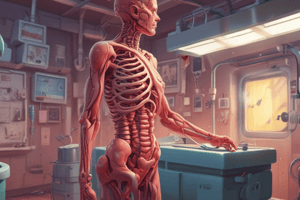Podcast
Questions and Answers
What is the primary treatment approach for a complete obstruction in the intestines?
What is the primary treatment approach for a complete obstruction in the intestines?
- Laparoscopic procedures
- Gastric suctioning
- Immediate surgical intervention (correct)
- Fluid replacement therapy
Which complication is associated with appendicitis?
Which complication is associated with appendicitis?
- Fat necrosis
- Perforation (correct)
- Achalasia
- Pyloric obstruction
What effect does obstruction at the pylorus have on vomiting?
What effect does obstruction at the pylorus have on vomiting?
- No effect on vomiting
- Delayed vomiting of undigested food
- Early, profuse vomiting (correct)
- Bile-stained vomiting
Which statement accurately describes the pathophysiology of acute pancreatitis?
Which statement accurately describes the pathophysiology of acute pancreatitis?
What is a possible treatment for malignant obstruction of the colon?
What is a possible treatment for malignant obstruction of the colon?
Which symptom is commonly associated with appendicitis?
Which symptom is commonly associated with appendicitis?
What role does activated trypsin play in the context of acute pancreatitis?
What role does activated trypsin play in the context of acute pancreatitis?
What is the primary mechanism of cell injury in acute pancreatitis?
What is the primary mechanism of cell injury in acute pancreatitis?
What classification of intestinal obstruction is characterized by any condition preventing the flow of chyme through the intestinal lumen?
What classification of intestinal obstruction is characterized by any condition preventing the flow of chyme through the intestinal lumen?
Which of the following is a consequence of intestinal obstruction?
Which of the following is a consequence of intestinal obstruction?
Which clinical manifestation is typically associated with a blockage in the pylorus?
Which clinical manifestation is typically associated with a blockage in the pylorus?
What condition could lead to a functional obstruction known as paralytic ileus?
What condition could lead to a functional obstruction known as paralytic ileus?
Which statement accurately describes major pathophysiological alterations due to intestinal obstruction?
Which statement accurately describes major pathophysiological alterations due to intestinal obstruction?
Which type of intestinal obstruction presents with symptoms like diarrhea or constipation, but is less severe compared to complete obstruction?
Which type of intestinal obstruction presents with symptoms like diarrhea or constipation, but is less severe compared to complete obstruction?
What is a key characteristic of inflammation or obstruction of the accessory organs of digestion?
What is a key characteristic of inflammation or obstruction of the accessory organs of digestion?
Which of the following is NOT a potential outcome of ischemia associated with intestinal obstruction?
Which of the following is NOT a potential outcome of ischemia associated with intestinal obstruction?
Study Notes
Disorders of the GI Tract
- Structural and neurological abnormalities can affect the movement of intestinal contents throughout the gastrointestinal tract.
- Inflammation in the GI tract can disrupt secretion, motility, and absorption.
- Liver, gallbladder, and pancreatic disorders can affect metabolism, resulting in local and systemic symptoms.
Intestinal Obstructions
- Obstructions can occur at any level of the small or large intestine.
- The small intestine is more commonly obstructed due to its narrower lumen.
- Paralytic ileus is a functional obstruction characterized by a failure of intestinal motility.
- Causes of Paralytic ileus include multifactorial interactions between the autonomic and central nervous system.
- Intestinal obstructions can cause fluid and electrolyte disturbances, metabolic alkalosis, metabolic acidosis, and hypokalemia.
Clinical Manifestations of Intestinal Obstructions
- Symptoms vary depending on the location, severity, stage, and presence of ischemia.
- Pylorus: Profuse, early vomiting.
- Proximal small intestine: Mild distention, bile-stained vomiting.
- Lower small intestine: Pronounced distention, delayed vomiting.
- Large intestine: Hypogastric pain, distention, late onset of vomiting.
- Partial Obstruction: Diarrhea or constipation, less severe symptoms than complete obstruction.
- Complete Obstruction: Constipation, increased bowel sounds, cramping pain, signs of hypovolemia and metabolic acidosis.
- Ischemia: Constant, severe pain due to compromised blood supply.
- Late Stage (Necrosis and Perforation): Fever, peritonitis, severe abdominal pain, and systemic inflammation.
Treatment for Intestinal Obstructions
- Fluid and electrolyte replacement.
- Gastric or intestinal suction.
- Laparoscopic procedures for adhesions.
- Immediate surgery for strangulation and complete obstruction.
- Colonic stent for malignant obstruction.
- IV antibiotics, fluid resuscitation, and surgery for intestinal perforation.
Appendicitis
- A medical emergency characterized by inflammation of the vermiform appendix.
- Potential causes include obstruction, ischemia, increased intraluminal pressure, infection, and inflammation.
- Symptoms include epigastric and periumbilical pain, rebound tenderness, nausea, vomiting, fever, and anorexia.
- Complications include perforation, peritonitis, and abscess formation.
- Treatment involves antibiotics, appendectomy, and supportive care (pain management and nutritional support).
Pancreatitis
- Inflammation of the pancreas.
- Associated with several clinical disorders like alcohol intake and cholelithiasis.
- Caused by damage to pancreatic cells and ducts, leading to leakage of pancreatic enzymes into the tissue.
- These enzymes autodigest pancreatic tissue, causing injury to blood vessels and other organs.
Pathophysiology of Acute Pancreatitis
- The primary mechanism of cell injury is intracellular calcium overload.
- Biliary reflux and ethanol metabolites in the pancreas contribute to pancreatic injury.
- Intracellular calcium overload causes inappropriate trypsin activation, impaired fluid and bicarbonate secretion in ductal cells, inflammation, and cell necrosis.
- Activated trypsin activates other enzymes like chymotrypsin, lipase, and elastase, further contributing to autodigestion.
- Autodigestion leads to vascular damage, coagulation necrosis, fat necrosis, and the formation of pseudocysts.
- Edema within the pancreatic capsule compresses the tissue, causing ischemia and necrosis.
- Cellular injury results in recurrent episodes of pancreatitis.
Studying That Suits You
Use AI to generate personalized quizzes and flashcards to suit your learning preferences.
Description
This quiz explores disorders of the gastrointestinal tract, focusing on structural and neurological abnormalities that disrupt the movement of intestinal contents. It also covers intestinal obstructions, their causes, symptoms, and clinical manifestations, including complications like metabolic disturbances.




